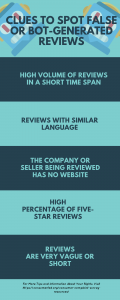Bots are computer programs that account for roughly 48% of all traffic to thousands of websites. Whether consumers are faced with good bots (e.g., indexing sites for Google) or bad bots (e.g., SPAM bots) matters greatly to consumer choice and purchasing behavior. According to a Nielsen study, two-thirds of consumers say they trust user reviews posted online. But are these reviews being made by humans or bots? Moreover, how many of these reviews are reliable?
According to recent studies, we should be less trusting of online reviews. In fact, one firm predicts that by 2020 a “digital distrust” will set in as people will consume more false information than true information. Evidence of this has become increasingly more apparent; Yelp labels approximately 25% of its reviews as “suspicious” and Airbnb has been accused of blocking negative reviews. Although it is illegal to ban honest reviews, businesses have tried to sue customers that left negative reviews on the grounds of defamation. Moreover, according to a recent consumer survey, 79% of people claim they’ve seen a fake review in the past year.
Fortunately, some action is being taken to help curtail the spread of misinformation. For example, Amazon banned reviews by people who get free or discounted products in exchange for making them and sued over 1,100 sellers of fake reviews. Law enforcement agencies also prosecute cases to halt companies from supplying fake reviews.
Still, with 84% of the people surveyed admitting they can’t always identify fake reviews, how can consumers rely on the information they read? Here are some clues to spot false or bot-generated reviews:
- High volume of reviews in a short time span
- Reviews with similar language
- The company or seller being reviewed has no website
- High percentage of five-star reviews
- Reviews are very vague or short
- Odd language and phrasing in reviews
Before making a purchasing decision, check reviews from multiple sources, use reputable review outlets like Consumers’ Checkbook or Consumer Reports, and even speak to sales staff trained on the products or services offered. As technology evolves, building trust in online information matters more than ever.
This blog is one of a series of articles contributed by state and local consumer agencies in connection with the annual survey about consumer complaints conducted by Consumer Federation of America. The survey report provides “real life” examples of complaints and tips for consumers. Have a consumer problem or question? Find your state or local consumer agency at https://www.usa.gov/state-consumer.


